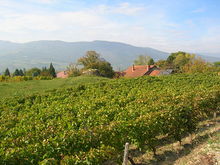Vin de Savoie

The designation of origin Vin de Savoie describes a red , rosé or white wine from the Savoie wine-growing region .
Approved municipalities
The approved vineyards are spread across the communes of Apremont , Arbin , Barby , Billième , Le Bourget-du-Lac , Brison-Saint-Innocent , Challes-les-Eaux , Chignin , Chindrieux , Cruet , Francin , Fréterive , Jongieux , Lucey , Les Marches , Montmélian , Motz , Myans , Ruffieux , Saint-Alban-Leysse , Saint-Baldoph , Saint-Germain-la-Chambotte , Saint-Jeoire-Prieuré , Saint-Jean-de-la-Porte , Saint-Jean-de- Chevelu , Saint-Pierre-d'Albigny , Serrières-en-Chautagne and Yenne (all in the Savoie department ) as well as Ayse , Ballaison (only red wine), Bassy , Bonneville , Challonges , Chaumont , Chessenaz , Clarafond-Arcine , Desingy , Douvaine ( red wine only), Frangy , Franclens , Loisin (red wine only), Marignier , Marin , Massongy , Musièges , Publier , Sciez , Seyssel (red wine only), Thonon-les-Bains , Usinens , Vanzy and Ville-la-Grand (all in Haute-Savoie department ). In addition, the area with the municipalities of Corbonod and Seyssel encompasses a small part of the orographically located right of the Rhone region in the Ain department . In the Isère department , the municipality of Chapareillan can also identify itself with the designation of origin. For the three last-mentioned municipalities, recognition only applies to red wine. This means that the definition of the growing area is almost identical to that of the Roussette de Savoie appellation .
In addition to the simple Vin de Savoie, 15 crus have been recognized with stricter regulations:
- Vin de Savoie Abymes or Les Abymes: Apremont (partially), Chapareillan, Les Marches (partially), Myans.
- Vin de Savoie Apremont: Apremont (partly), Les Marches (partly), Saint-Baldoph.
- Vin de Savoie Arbin: Arbin.
- Vin de Savoie Ayze: Ayse, Bonneville, Marignier.
- Vin de Savoie Chautagne: Chindrieux, Motz, Ruffieux, Serrières-en-Chautagne.
- Vin de Savoie Chignin: Chignin.
- Vin de Savoie Chignin-Bergeron or Bergeron: Chignin, Francin, Montmélian.
- Vin de Savoie Cruet: Cruet.
- Vin de Savoie Marignan: Sciez.
- Vin de Savoie Montmélian: Francin, Montmélian.
- Vin de Savoie Ripaille: Thonon-les-Bains.
- Vin de Savoie Saint-Jean-de-la-Porte: Saint-Jean-de-la-Porte.
- Vin de Savoie Saint-Jeoire-Prieuré: Saint-Jeoire-Prieuré.
- Vin de Savoie Marin: Marin, Publier.
- Vin de Savoie Jongieux: Billième, Jongieux, Lucey, Saint-Jean-de-Chevelu, Yenne.
Since September 4th 1973 the appellation has the status of an Appellation d'Origine Contrôlée (AOC for short).
The vineyards are located at an average height of approx. 250 to 560 meters above sea level on the slopes of the foothills of the Savoy Alps . Due to the southern orientation of the slopes, the vineyards are protected from the cold north winds. During the night, cool air falls from the heights and ensures a sufficiently high temperature difference between day and night, which is beneficial for viticulture.
Grape varieties
In general, the yields for red wines are limited to 62 hectoliters / hectare and for white wine and rosé wine to 67 hectoliters / hectare. Stricter rules apply to the 15 crus; here the restriction is 60 hectoliters / hectare or 65 hectoliters / hectare.
The most important red grape varieties for the red and rosé wine are the Gamay , the Mondeuse variety and the Spätburgunder , which is called Pinot Noir in France . The minor varieties include Persan , Cabernet Franc , Cabernet Sauvignon , Étraire de la Dui , Servanin and Joubertin . The proportion of secondary varieties in the blend must not exceed the 10% mark.
The main types of white wine are Aligoté , Altesse ( called Roussette here ), Chardonnay , Frühroter Veltliner , Jacquère and Mondeuse Blanche . In the Haute-Savoie department, this category also includes the varieties Roussanne (called Bergeron here), Gringet , Roussette d'Ayze and Gutedel , which is called Chasselas here . The Marsanne and Verdesse grape varieties are among the secondary varieties, the proportion of which in wine must not exceed 10%.
Before fermentation , the natural minimum sugar content of the must for red wine must be 144–153 g / l, which corresponds to an alcohol content of 9–10% by volume in the wine (→ must weight ). For the white wines, the values are 136–153 g / l, whereby the grape variety is considered to be the Kreiterium. For the 15 crus, the corresponding values are 153–162 g / l for the red wine, while there is no special rule for the white wine. If chaptalization is approved in bad years , the alcohol content of the finished fermented wine must not exceed 13% by volume.
The planting density is at least 5000 vines / hectare.
literature
- Jancis Robinson : The Oxford Wine Lexicon. 2nd, completely revised edition. Hallwag, Munich 2003, ISBN 3-7742-0914-6 .
- Pierre Galet : Cépages et Vignobles de France . Lavoisier Publishing House, Paris 2004, ISBN 2-7430-0585-8 .
- Benoît France: Grand Atlas des Vignobles de France . Éditions SOLAR publishing house, Paris 2002, ISBN 2-263-03242-8 .